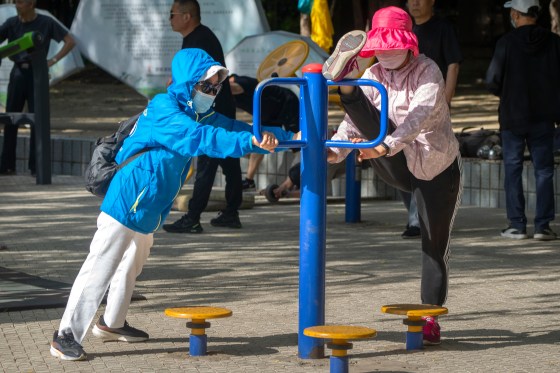Last week when a Chinese senior health adviser projected 65 million COVID-19 cases per week in China by June, some health experts sounded the alarm.
China has been facing a new COVID-19 wave fueled by the XBB variant since April. Data from Zhong Nanshan—a respiratory disease doctor who was among the first to confirm COVID-19’s easy transmissibility—provided a rare insight into how the disease could possibly be spreading in China almost six months after Beijing abruptly ended its draconian zero-COVID strategy.
Since pivoting to “living with the virus” policy from early December, the Chinese Center for Disease Control and Prevention stopped updating weekly infections. But the sudden relaxation of anti-epidemic protocols also led to an estimated 37 million new infections a day weeks later. By January, experts said they believed almost 80% of China’s 1.4 billion population had already been infected in this first wave.
[time-brightcove not-tgx=”true”]
For the second wave since April, Zhong’s modeling revealed that the XBB variant is expected to cause 40 million infections weekly by May, going up to 65 million in June. This goes against the grain of Chinese health officials’ estimate that the wave had peaked in April. In Beijing, the number of new infections recorded between May 15 and 21 grew four times in four weeks.
While Zhong said vaccines targeting this specific variant will be rolled out soon, the projection of new COVID-19 infections nonetheless frazzled markets. China’s collective immunity has always been in question: a refusal to use foreign-sourced mRNA vaccines meant the public got inoculated against COVID-19 with a jab that proved less effective in preventing infection during early clinical trials, say researchers, and the stringent virus containment protocols restricted the possibility of developing natural immunity.
Yanzhong Huang, senior fellow for global health at the Council on Foreign Relations, tells TIME that although only mass testing can detect the true extent of the COVID-19 surge, the population has obtained some immunity from the preceding wave.
“We shouldn’t worry if China doesn’t worry,” Huang says. “Public health officials try to downplay the severity of this second wave. The Chinese people seem to have learned to co-exist with the virus. There’s that social adaptability.”

Compared to countries like the U.S. and Australia, China has just begun transitioning COVID-19 from a pandemic to an endemic disease. Catherine Bennett, an epidemiologist at Deakin University in Australia, says the new wave “tests the effectiveness of their vaccines and their boosters,” adding that Beijing must ensure everyone’s vaccines are up to date—especially the elderly and the vulnerable population.
Chinese data a concern
With the virus continuing to circulate in China coupled with a waning public immunity, the possibility of a new, more dangerous sub-variant emerging still exists, Bennett adds, although the likelihood is much smaller now. The latest mutations in the genetic makeup of the SARS-CoV-2 virus have not been significantly different from the last major variant, Omicron, and the symptoms of infections are relatively milder. “It’s somewhat reassuring, thus, now a year and a half into Omicron, that we haven’t seen a major shift that’s either undermined our immunity, our testing capability, and importantly, antivirals,” Bennett adds.
But another factor that affects the prognosis for China is its willingness to share information. Independent experts have been skeptical of China’s official COVID-19 figures, forcing many to record their own statistics. A delayed release in China’s marriage and funeral data for the October-December 2022 period has also raised speculation that the country has yet to determine the true extent of the infection spread of its first wave.
Vincent Pang, an assistant professor at the Duke-NUS Medical School in Singapore, says data on the spread and impact of COVID-19 will only be of use if shared with others on a global, well-regulated platform, so that these countries can perform their own risk assessment. “Infectious disease does not respect geographical boundaries,” he tells TIME. “No one is safe until everyone is ready and safe.”

Post A Comment:
0 comments: